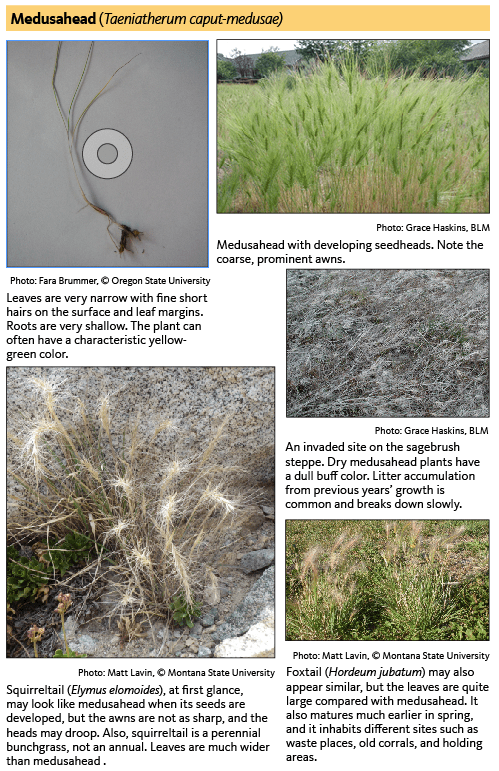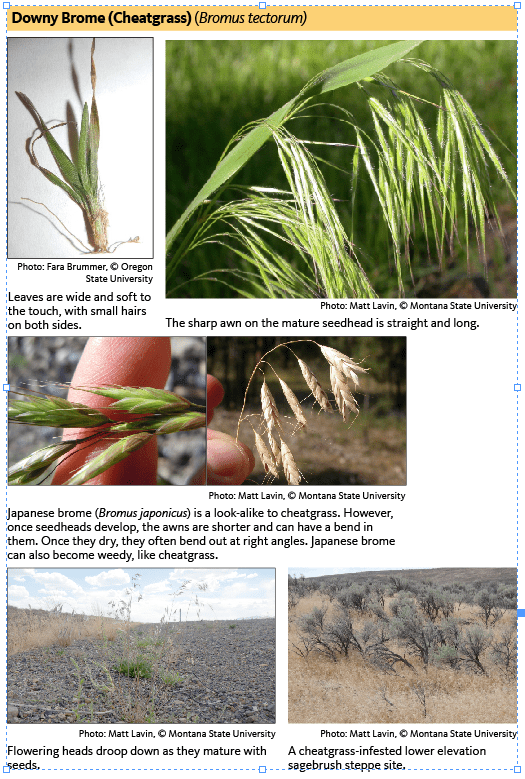Invasive annual grasses are a threat to the Great Basin desert ecosystem. They compromise habitat diversity for important wildlife species such as the greater sage-grouse. They shorten the grazing season for livestock, and do not provide as much consistent forage biomass and quality as perennial native bunchgrasses. They tend to be much smaller, have less overall leaf area, and capitalize on early season moisture. In fact, one annual grass, medusahead, can reduce livestock carrying capacity by 50 to 80 percent. Invasive annual grasses typically have a shallow root system. Shallow root systems limit forage availability to early season use, particularly during drought years. Once these grasses gain a foothold, they can progressively dominate a system, as they germinate in the fall and generally “green up” earlier than our native grasses. Invasive annual grasses increase wildfire threat as they can provide an abundant source of dry “fine fuels” earlier in the season than native bunchgrasses.
The first step in managing these species is awareness of the annual grass and surrounding range conditions that are most at risk to invasion. Once an invasive annual grass has been identified in an area, strategies to limit their impact should be long-term and consistent to ensure the health of rangelands and pastures. The three major invasive annuals included in this publication are downy brome (cheatgrass), medusahead wildrye, and ventenata.
|
Name |
Time of Germination/Emergence/ Seed Dispersal |
Habitat Types |
Grazing Suitability |
Nonchemical Control |
Commonly Used Herbicide Control |
Herbicide Time of Application |
|
Downy Brome (Cheatgrass)(Bromus tectorum) |
Germination Fall, following moisture accumulation Emergence Early fall if moisture is available, or in spring Establishment by seed, which is prolific. Seed can be soil banked over time. Seeds can persist up to 5 years in the field. |
Disturbed sites over a variety of soil types |
Early spring. (Protein levels can be 20% or more). Seedhead awns can irritate eyes or create abcesses in late summer. Can be grazed in winter for targeted control with the use of protein supplementation. |
|
|
Depending on product, pre-emergent applications in fall through post-emergent applications in spring are most effective. Check product label and consult your county or BLM weed specialist. |
|
Medusahead wildrye (Taeniatherum caput-medusae) |
Germination Mostly fall, although some can germinate in winter through spring Emergence Early fall through spring, depending on moisture conditions and thatch layer Establishment By seeds, less than 6 feet away from parent plant. Mature seeds are dispersed from July–October. Seeds can persist 2 years in the field. |
|
|
|
|
Depending on product, pre-emergent applications in fall through post-emergent applications in spring are most effective. Check product label and consult your county or BLM weed specialist. |
|
Ventenata (Ventenata dubia) |
Germination: Fall (soil temperature between 48oF – 84oF) Emergence: Fall through spring, depending on site and old ventenata litter level on site Establishment: Seed, which is produced from May to August. Seed can persist up to 2 years in the field. |
|
|
|
Late fall. Check product label and consult your county or BLM weed specialist. |
+ Herbicide is approved on BLM-managed ground on western U.S. rangelands.
++ Herbicide is approved on BLM-managed ground on western U.S. rangelands, but may NOT be aerially applied.
* Certain formulations of this chemical may not be aerially applied on BLM managed ground on western U.S. rangelands.
+* Resistance has occurred in Group 1 and 2 herbicides in the Pacific Northwest.
Check with your local BLM office on specific formulations and local restrictions.
For more detailed information, contact your local Extension agent, weed management specialist, or county weed master.
Additional resources
Oregon State University Extension, Pacific Northwest’s Least Wanted List: Invasive Weed Identification and Management (EC 1563)
USDA NRCS Plant Materials website: https://plants.usda.gov
Ecologically Based Invasive Plant Management: website, manuals, and information at http://www.ebipm.org/
Medusahead Management Guide for the Western States. University of California, Weed Research and Information Center, Davis. www.wric.ucdavis.edu
References
- Bansal, S., R. Sheley. 2016. Annual Grass Invasion in Sagebrush Steppe: The Relative Importance of Climate, Soil Properties and Biotic Interactions. Oecologia. 181: 543–557
- Cook, W., L. Harris. 1952. Nutritive Value of Cheatgrass and Crested Wheatgrass on Spring Ranges of Utah.
- Davies, K.W. 2008. Medusahead Dispersal and Establishment in Sagebrush Steppe Plant Communities. Journal of Rangeland Management and Ecology. 61: 110–115
- DiTomaso, J.M., G.B. Kyser et al. 2013. Weed Control in Natural Areas in the Western United States. Weed Research and Information Center, University of California. 544 pp
- Hironka, M. 1961. The relative rate of root development of cheatgrass and medusahead. Journal of Range Management. 14, 263–267.
- Kyser G.B., J.M. DiTomaso, K.W. Davies, J.S. Davy, B.S. Smith. 2014. Medusahead Management Guide for the Western States. University of California, Weed Research and Information Center, Davis. 68 p. www.wric.ucdavis.edu.
- Miller, H.C., D. Clausnitzer, M.M. Borman. 1999. Medusahead. In Sheley, R. L. and J.K. Petroff (eds.). Biology and management of Noxious Rangeland Weeds. Oregon State University Press, Corvallis, OR.
- Peachey, E., editor. 2017. Pacific Northwest Weed Management Handbook. Corvallis, OR. Oregon State University. http:pnwhandbooks.org/weed.
- Wallace, J., T. Prather. 2016. Herbicide Control Strategies for Ventenata dubia in the Intermountain Pacific Northwest. Invasive Plant Science and Management, 9(2):128–137
- Wallace, J., P. Pavek, T. Prather. 2015. Ecological Characteristics of Ventenata dubia in the Intermountain Pacific Northwest. Invasive Plant Science and Management. 8: 57–71
© 2018 Oregon State University.
Extension work is a cooperative program of Oregon State University, the U.S. Department of Agriculture, and Oregon counties. Oregon State University Extension Service offers educational programs, activities, and materials without discrimination on the basis of race, color, national origin, religion, sex, gender identity (including gender expression), sexual orientation, disability, age, marital status, familial/parental status, income derived from a public assistance program, political beliefs, genetic information, veteran’s status, reprisal or retaliation for prior civil rights activity. (Not all prohibited bases apply to all programs.) Oregon State University Extension Service is an AA/EOE/Veterans/Disabled.



